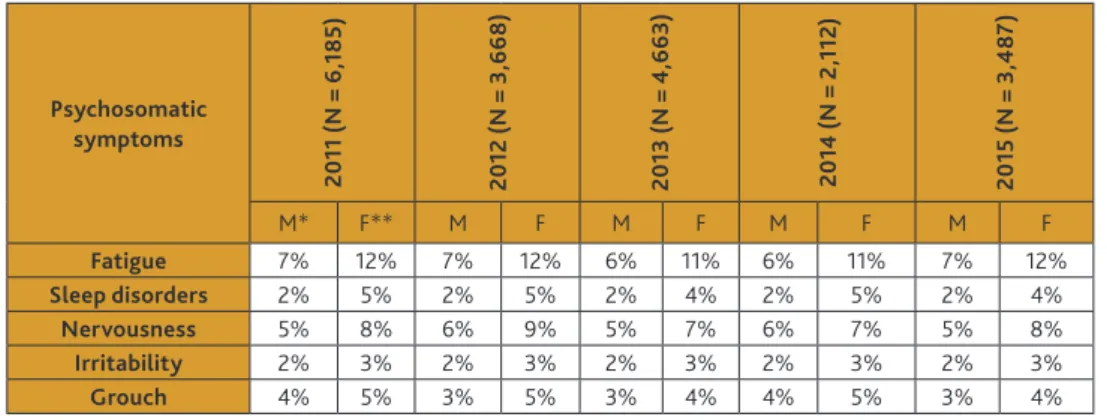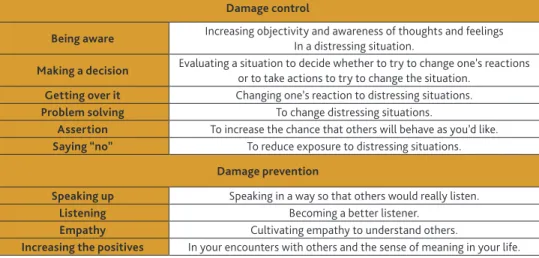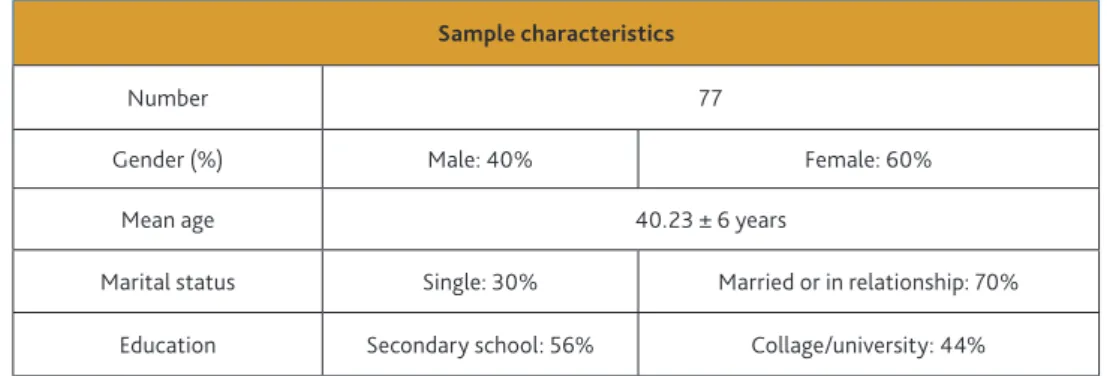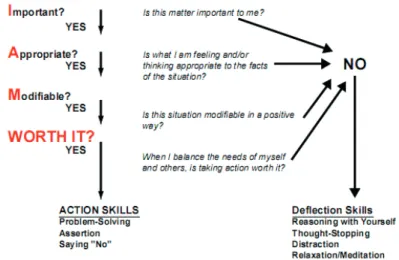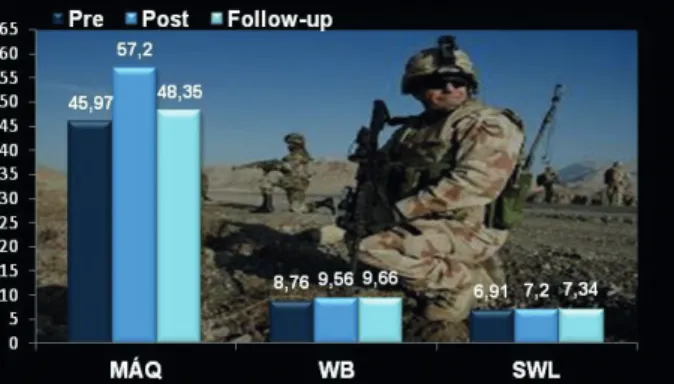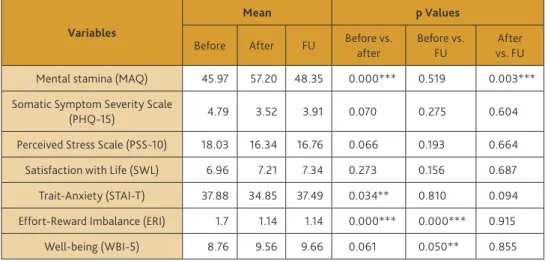Hornyák Beatrix
1Implementation of a Behavioural Medicine Program in the Hungarian
Defence Forces: The Williams LifeSkills Experience II
Egy magatartásorvoslási program bevezetése a Magyar Honvédségben:
A Williams Életkészségek tréning tapasztalatai II
Abstract
In the first part of my article I was presenting the main knowledge of psychosocial risks and work-related stress especially in the military organisation, some of the main theories of work-related stress, and the general overview of psychosocial risk manage- ment interventions. Now, in the second part of the article, I present the main steps of the implementation process of a behavioural medicine program – Williams LifeSkills Training (WLS®) – in the HDF and the results of its effectiveness assessment. The main result of my study is that an individually focused intervention was effective in decreasing work-related stress (ERI) and in increasing resilience (MAQ) and well-being (WBI-5), and these positive changes were maintained in the 3 months follow-up, as well.
Keywords: Williams LifeSkills Training, stress management, resilience, effectiveness, Hungarian Defence Forces
1 Nemzeti Közszolgálati Egyetem, Hadtudományi Doktori Iskola, doktoranduszhallgató – National University of Public Service, Doctoral School of Military Sciences, PhD student, e-mail: bea.hornyak@gmail.com, ORCID: 0000-0003- 1499-7625
Absztrakt
Cikkem első részében a pszichoszociális kockázatokkal és a munkahelyi stresszel kapcsolatos főbb ismereteket, néhány meghatározó munkahelyistressz-elméletet mutattam be és egy általános áttekintést nyújtottam a pszichoszociális kockázat kezelés lehetőségeiről. A cikk második részében egy magatartásorvoslási program – Williams Életkészségek Program (WLS®) – Magyar Honvédségen belüli bevezetésének lépéseit és hatékonyságvizsgálatának eredményeit mutatom be. Tanulmányom fő eredménye, hogy az egyéni fókuszú intervenció hatékonyan csökkentette a munkahelyi stressz szintjét (ERI) és növelte a mentális állóképességet (MÁQ) és a jól-létet (WBI-5), mely pozitív változások a 3 hónapos követés alatt is fennálltak.
Kulcsszavak: Williams Életkészségek Tréning, stresszkezelés, reziliencia, hatékonyság, Magyar Honvédség
Introduction
Several studies suggest that behavioural interventions – as the secondary stress management programmes – can reduce the levels of psychosocial risk factors and work-related stress. The introduction of a stress management training program into a military organisation requires careful planning which takes into account possible barriers to dealing with stress. There are many who will resist the introduction of new trainings in the military settings. One of the reasonable questions of the Defence Leadership is: why invest the time, money and effort into a new stress management training? That is why one of the major challenges to introducing a stress manage- ment program within the military culture is getting support from the leadership.
A second source for potential resistance will be the lack of efficacy study of these training. Is the new training able to reduce stress effectively? Although the value of these training is widely accepted, little is known empirically about the program’s effectiveness. The answer to the first question will be roughly presented in the first part of my article (e.g. psychosocial risks and their health consequences) therefore in this study I present only the most important causes and consequences of work-re- lated stress in the Hungarian Defence Forces. The second question is answered in my current article.
Why and Why Now?
According to the human management policy of the Hungarian Defence Forces, the personnel is primarily a resource, which is the most important, developable and lasting capital of the military. The effectiveness of the HDF mainly depends on the quality of the human components of the organisation thus the only way of achieving the goals of the organisation is developing the human capabilities, side by side with
the technical modernisation.2 According to the latest survey of the parliamentary commissioner on the Hungarian Defence Forces, the most significant human resources problems are high fluctuation, lack of staff, frequent overtime and low wages.3 Another problem is that due to the dual-earner family model, the willingness of mobility is low, the proportion of commuters and separates is high, which increases the frequency of private life problems and that due to frequent reorganisations there is a high fear of loss of work and uncertainty. As I mentioned in the first part of my article when the routine stressors (e.g. low autonomy and little control over the work, the ineffective leadership, the unsupportive colleagues, the role conflict and role ambiguity, the reductions in the uniformed workforce and cuts to the public service, the increased demands on individuals) have increased, the justification of stress management train- ing could be very real. Possibly, the more compelling reason for introducing a stress management-training program, is the mental health of the soldiers of the Hungarian Defence Forces but unfortunately according to the Hungarian law, the Army does not provide data related to combat capability. The frequency of psychosomatic symp- toms is considered to be one of the most important indicators of workplace stress.
Based on the health screening data, the frequency of psychosomatic symptoms in the Hungarian Defence Forces was established in Table 1.
Table 1. 6-month prevalence of psychosomatic symptoms occurring frequently (daily or several times a week) between 2011 and 2015 in the HDF.
Psychosomatic symptoms
2011 (N = 6,185) 2012 (N = 3,668) 2013 (N = 4,663) 2014 (N = 2,112) 2015 (N = 3,487)
M* F** M F M F M F M F
Fatigue 7% 12% 7% 12% 6% 11% 6% 11% 7% 12%
Sleep disorders 2% 5% 2% 5% 2% 4% 2% 5% 2% 4%
Nervousness 5% 8% 6% 9% 5% 7% 6% 7% 5% 8%
Irritability 2% 3% 2% 3% 2% 3% 2% 3% 2% 3%
Grouch 4% 5% 3% 5% 3% 4% 4% 5% 3% 4%
* Male; ** Female
Source: Hornyák–Sótér (2015): op. cit. 60–68.
In view of the above, I believe it is justified to introduce an effective stress man- agement training program among the personnel of the Hungarian Defence Forces (HDF). The first question is which aspects to consider, to choose the appropriate
2 Kolossa László: Humánerőforrás fejlesztés a Magyar Honvédségben, Kard és Toll, (2006/1) 17–23.
3 Somosi György – Szabó Máté: A Magyar Honvédséget érintő országgyűlési biztosi vizsgálat tapasztalatai, Nemzet és Biztonság, 3 (2010/7) 73–85.
stress management training program. As I mentioned in the first part of my article evidence based stress management training programs designed to develop individual coping skills are complex, multi-modular, and typically include elements of cognitive and behavioural therapy, as well as relaxation techniques.4 Behavioural medicine programs are theoretically well-grounded, planned, complex interventions that take into account that changing a habit of behaviour, creating a new and more adaptive behaviour is a complex psychological process.
In view of the above, we looked for a program that meets these criteria. Following the literature review, we selected the Williams LifeSkills® (WLS®) program, which is a short, well-structured and complex behavioural medicine intervention compiled on the basis of research results and clinical experience. The program was developed in the USA by Virginia Williams and Redford Williams and aim to improve coping skills.5 They derived a set of 10 skills (Table 2) designed to reduce negative psychosocial factors and to increase positive factors like self-esteem, optimism and satisfaction with life.
Table 2. A set of 10 skills of the WLS.®
Damage control
Being aware Increasing objectivity and awareness of thoughts and feelings In a distressing situation.
Making a decision Evaluating a situation to decide whether to try to change one’s reactions or to take actions to try to change the situation.
Getting over it Changing one’s reaction to distressing situations.
Problem solving To change distressing situations.
Assertion To increase the chance that others will behave as you’d like.
Saying “no” To reduce exposure to distressing situations.
Damage prevention
Speaking up Speaking in a way so that others would really listen.
Listening Becoming a better listener.
Empathy Cultivating empathy to understand others.
Increasing the positives In your encounters with others and the sense of meaning in your life.
Source: Williams–Williams (2011): op. cit.
The first six skills are for “damage control”: something distressing happened and you need to be aware of the objective facts of the situation and your thoughts and feel- ings so that you can evaluate them objectively and make rational decisions whether
4 Albus, Christian – Theissen, Peter – Hellmich, Martin – Griebenow, Reinhard – Wilhelm, Beate – Aslim, Demet – Schischa, Harald – Köhle, Karl: Long-Term Effects of a Multimodal Behavioral Intervention on Myocardial Perfusion – A Randomi- zed Controlled Trial, International Journal of Behavioral Medicine, 16 (2009/3) 219–226. DOI: https://doi.org/10.1007/
s12529-008-9030-4; Van der Klink, Jac J. L. – Blonk, Roland W. B. – Schene, Aart H. – van Dijk, Frank J. H.: The benefits of interventions for work-related stress, American Journal of Public Health, 91 (2001/2) 270–276.
5 Williams, Redford B. – Williams, Virginia P.: Adaptation and Implementation of an Evidence-Based Behavioral Medicine Program in Diverse Global Settings: The Williams LifeSkills Experience, Translational Behavioral Medicine, 1 (2011/2) 303–312.
this is a situation where you need to change your reaction or one where you need to take effective action to change the situation. The last four skills serve the purpose of “damage prevention”. By speaking in a way so that others would listen, listening well, cultivating empathy to understand others and increasing the sense of meaning in your life, you decrease the likelihood that these encounters become sources of distress and make it more likely that you will increase your sense of feeling supported by others. The Hungarian adaptation of the program was carried out by the staff of the Institute of Behavioural Sciences at Semmelweis University in 2004, and they are continuously developing it.6 Evidence from published controlled and observa- tional trials of WLS® training in Hungary and elsewhere shows that persons receiving coping skills training using WLS® products have consistently reported reduced level of stress and stress-related symptoms.7 The WLS® program teaches simple skills used in everyday life, which are essential for the successful management of every- day mental or emotional strains and conflicts. In order to ensure quality assurance, training groups can only be run by certified WLS® facilitators trained by Semmelweis University staff. They make a train-the-trainer program (Facilitator program) and provide continuous supervision to the facilitators, as well. The program consists of sixteen 45-minute sessions.
To introduction the WLS® program in the HDF, we contacted the Institute of Behavioural Sciences of the Semmelweis University in 2013. We signed a collabora- tion agreement for the training of facilitators and to keep the WLS® programs free of charge in the HDF, from 17 October to 29 November 2013, 12 people within the staff of the HDF were trained at the Semmelweis University; they can keep the WLS® program as facilitators. The WLS® anger and stress management training has been available for Hungarian Defence Forces military personnel since 2014.
In the rest of my study I examined the real-life implementation of a cogni- tive-behavioural therapy-based, stress reducing intervention, the WLS program.
Specifically, I aimed to identify the impact of this intervention on work-related stress and stress-related symptoms. My aim was testing the effectiveness of the WLS® stress management skills training program in the HDF.
6 Stauder, Adrienne – Konkolÿ Thege, Barna – Kovács, Mónika Erika – Balog, Piroska – Williams, Virginia P. – Williams, Redford B.: Worldwide Stress: Different Problems, Similar Solutions? Cultural Adaptation and Evaluation of a Stan- dardized Stress Management Program in Hungary, International Journal of Behavioral Medicine, 17 (2010/1) 25–32.
7 Gidron, Yori – Davidson, Karina – Bata, Iqbal (1999): The short-term effects of a hostility-reduction intervention on male coronary heart disease patients, Health Psychology, 18 (1999/4) 416–420; Williams, Virginia P. – Brenner, Sharon L. – Helms, Michael J. – Williams, Redford B.: Coping skills training to reduce psychosocial risk factors for medical disor- ders: a field trial evaluating effectiveness in multiple worksites, Journal of Occupational Health, 51 (2009/5) 437–442;
Williams, Virginia P. – Bioshop-Fitzpatrik, Lauren – Lane, James D. – Gwyther, Lisa P. – Ballard, Edna L. – Vendittelli, Analise P. – Hutchins, Tiffany C. – Williams, Redford B.: Video-Based Coping Skills to reduce health risk and improve psychological and physical well-being in Alzheimer’s disease family caregivers, Psychosomatic Medicine, 72 (2010/9) 897–904; Williams–Williams (2011): op. cit.; Bishop, George D. – Kaur, Divjyot – Tan, Vicky L. M. – Chua, Yeow- Leng – Liew, Siok-Moey – Mak, Koon Hou: Effects of a psychosocial skills training workshop on psychophysiological and psychosocial risk in patients undergoing coronary artery bypass grafting, American Heart Journal, 150 (2005/3) 602–609; Stauder et al. (2010): op. cit.; Kirby, Elizabeth D. – Williams, Virginia P. – Hocking, Matthew C. – Lane, James D. – Williams, Redford B.: Psychosocial benefits of three formats of a standardized behavioral stress management program, Psychosomatic Medicine, 68 (2006/6) 816–823; Stauder, Adrienne – Cserháti, Zoltán – Konkolÿ Thege, Bar- na: Decreasing the Negative Effects of Work-Related Stress in Unchanged Working Environments, European Journal of Mental Health, 13 (2018/2) 163–183.
The Effectiveness of the Wls
®Stress Management Training in the Hdf
Methods
Sample and procedure
To investigate the effectiveness of WLS,® I made a cross-sectional study of the personnel who were serving at the HDF and took part in the WLS® training in 2015.
A minimal fee (1000 HUF) was required for participation to cover the costs of the workbook. Participants were asked to complete questionnaires before the beginning and at the end of the training. The follow-up questionnaires were mailed to the par- ticipants an average of 3 months after the training. All participants completing the questionnaire signed an informed consent form for scientific analysis of their data;
participation was voluntary. The sample size was 77 at the beginning of the training and by the end of the 3-month follow-up the drop rates were 24%. The main demog- raphic characteristics of the sample are summarised in Table 3.
Table 3. The main demographic characteristics of the participants of the WLS® training in the HDF.
Sample characteristics
Number 77
Gender (%) Male: 40% Female: 60%
Mean age 40.23 ± 6 years
Marital status Single: 30% Married or in relationship: 70%
Education Secondary school: 56% Collage/university: 44%
Source: Compiled by the author.
The intervention
In 2015, there were five WLS® trainings organised. The intervention was delivered in small groups (6–12 participants) over sixteen 45-minute sessions. As I mentioned earlier, the content of the training focuses 10 skills: identifying problem situations, decision making, decreasing negative thoughts and emotions, problem solving, asser- tion, saying „No”, improving empathy and communication (speaking and listening) and increasing our positive expressions. The main skill of the program is the “I AM WORTH IT” Roadmap which is to evaluate one’s thoughts and feelings about the distressing situation by asking four questions:
• Is this situation IMPORTANT enough to warrant my continuing attention?
• Are my thoughts and feelings APPROPRIATE to the objectives facts?
• Is the situation MODIFIABLE (or if I’m not sure, ought it be?)
• When I consider myself and the others involved, would it be WORTH IT to take the actions necessary to change the situation?
If we get NO to any of these questions, we need to practice Deflection Skills to change the thoughts and feelings being experienced. Four YES indicates that we need to take Action Skills.8
Figure 1. The main decision making skill of the WLS.®
Source: Williams–Williams (2011): op. cit.
To teach and practice these coping skills psychoeducation, cognitive and behavioural techniques, role-playing and relaxation techniques were used.
Measures
To test the effectiveness of the WLS® training, I used a self-reported questionnaire and included the Hungarian versions of standardised, internationally recognised questionnaires (ERI, PSS-10, STAI-T, PHQ, WBI-5 and SWL) and a Mental Adversity Quotient (MAQ) questionnaire, which has been developed for the Hungarian military
8 Williams–Williams (2011): op. cit.
personnel to measure mental stamina and resilience. Work related stress was assessed by Siegrist’s ERI (Effort-Reward-Imbalance) model.9 The instrument, adapted and validated in Hungary10 comprises 15 questions. Effort was assessed with 3 items, and reward with 6 items answered on a five-point Likert-scale. The effort-reward imbal- ance (ERI) was calculated as effort divided by reward. Overcommitment was assessed with 6 items answered on a four-point Likert scale. The Hungarian version of the 10-item perceived stress scale (PSS-10) was used to measure the participants’ per- ception of stress.11 Anxiety was measured by the Hungarian version of the “Trait”
part of Spielberger’s State-Trait Anxiety Inventory (STAI-T), the 20 items answered on a four-point Likert scale.12 To measure subjective health complaints I used the 15-item Somatic Symptom Severity Scale (PHQ-15).13 General psychological well-be- ing was assessed with a shortened, 5-item Hungarian version of the WHO Wellbeing Questionnaire (WBI-5).14 Satisfaction with life was measured by a single question (“Taken as a whole, to what extent are you satisfied with your life at the moment?”) answered on a ten-point Likert-scale. The Mental Adversity Quotient questionnaire contains 20 statements; answers must be given on a five-point Likert scale. The MAQ questionnaire was constructed in 2006 especially for the Hungarian military personnel according to Stoltz’s Adversity Quotient concept.15
Statistical methods
To evaluate the effectiveness of the WLS® program, paired sample t-tests were used, comparing the baseline, the end-of intervention and the follow-up test scores.
Statistical significance was set at p value of < 0.05.
9 Siegrist, Johannes – Starke, Dagmar – Chandola, Tarani – Godin, Isabelle – Marmot, Michael – Niedhammer, Isabelle – Peter, Richard: The Measurement of Effort-Reward Imbalance at Work: European Comparisons, Social Science &
Medicine, 58 (2004/8) 1483–1499.
10 Salavecz Gyöngyvér – Neculai Krisztina – Rózsa Sándor – Kopp Mária: Az Erőfeszítés-Jutalom Egyensúlytalanság Kérdőív magyar változatának megbízhatósága és érvényessége, Mentálhigiéné és Pszichoszomatika, 7 (2006/3) 231–246.
11 Cohen, Sheldon – Kamarck, Tom – Mermelstein, Robin: A Global Measure of Perceived Stress, Journal of Health and Social Behavior, 24 (1983/4) 385–396; Stauder, Adrienne – Konkoly Thege, Barna: Az észlelt stressz kérdőív (PSS) magyar verziójának jellemzői, Mentálhigiéné és Pszichoszomatika, 7 (2006/3) 203–216.
12 Spielberger, C. D. – Gorsuch, R. L. – Lushene, R. E.: Manual for the State-Trait Anxiety Inventory, Paolo Alto, Consul- ting Psychologists Press, 1970; Sipos Kornél – Sipos Mihály – Spielberger, Charles D.: A State-Trait Anxiety Inventory (STAI) magyar változata, in: Mérei Ferenc – Szakács Ferenc (eds.): Pszichodiagnosztikai vademecum I/2, Nemzeti Tankönyvkiadó, Budapest, 1994, 123–148.
13 Kroenke, Kurt – Spitzer, Robert L. – Williams, Janet B.: The PHQ-15: Validity of a New Measure for Evaluating the Severity of Somatic Symptoms, Psychosomatic Medicine, 64 (2002/2) 258–266.
14 Bech, P. – Gudex, C. – Staehr Johansen, K.: The WHO (Ten) Well-Being Index: Validation in Diabetes, Psychotherapy and Psychosomatics, 65 (1996/4) 183–190; Susánszky, Éva – Konkoly Thege, Barna – Stauder, Adrienne – Kopp, Mária:
A WHO jól-lét kérdőív rövidített (WBI-5) magyar változatának validálása a Hungarostudy 2002 országos lakossági egészségfelmérés alapján, Mentálhigiéné és Pszichoszomatika, 7 (2006/3) 247–255.
15 Stoltz, Paul G.: Adversity Quotient: Turning Obstacles into opportunities, John Wiley and Sons, New York, 1997; Szilágyi Zsuzsanna – Csukonyi Csilla – Sótér Andrea – Hornyák Beatrix: A mentális állóképesség-vizsgálatok bevezetésének lépései a Magyar Honvédség állományában (2006–2009), Hadtudományi Szemle, 7 (2014/1) 158–178.
Results
Directly after the training positive mental health indicators such as mental stamina (MAQ), well-being (WBI-5) and satisfaction with life showed improvement (see details in Figure 2) but it was statistically significant only in the score of MAQ (t = – 4.32;
df = 94.26; p = 0.000).
Figure 2. Outcomes in the score of positive mental health indicators.
Source: Compiled by the author.
All stress-related symptoms (subjective somatic complaints (PHQ-15), perceived stress (PSS-10), symptoms of anxiety (STAI-T)) decreased (Figure 3) but it was statistically significant only in trait-anxiety (t = 2.13, df = 142; p = 0.034).
Figure 3. Outcomes of stress-related psychological symptoms.
Source: Compiled by the author.
I experienced significant improvement (t = 4.56; df = 107.88; p = 0.000) in work stress score in the high stress level group (ERI ratio > 0.8). (Figure 4.)
Figure 4. Outcomes in work stress (ERI score).
Source: Compiled by the author.
To examine the long-term effects of the training, the initial values were compared to the 3-month follow-up values. Although all examined variables changed in a favourable direction, the difference between the baseline and follow-up scores were significant only in well-being (t = 1.93; df = 106.20; p = 0.050) and in work stress (t = – 4,59;
df = 121.67; p = 0.000) score. I summarised the main results in Table 4.
Table 4. Outcomes of the WLS® training: before training, after training and follow-up (FU) scores (** p < 0.05; *** p < 0.000).
Variables
Mean p Values
Before After FU Before vs.
after
Before vs.
FU
After vs. FU Mental stamina (MAQ) 45.97 57.20 48.35 0.000*** 0.519 0.003***
Somatic Symptom Severity Scale
(PHQ-15) 4.79 3.52 3.91 0.070 0.275 0.604
Perceived Stress Scale (PSS-10) 18.03 16.34 16.76 0.066 0.193 0.664 Satisfaction with Life (SWL) 6.96 7.21 7.34 0.273 0.156 0.687 Trait-Anxiety (STAI-T) 37.88 34.85 37.49 0.034** 0.810 0.094 Effort-Reward Imbalance (ERI) 1.7 1.14 1.14 0.000*** 0.000*** 0.915
Well-being (WBI-5) 8.76 9.56 9.66 0.061 0.050** 0.855
Source: Compiled by the author.
Discussion
In this research, the Hungarian version16 of the Williams LifeSkills program has been implemented in the Hungarian Defence Forces. My study’s main result was that an individually focused intervention was effective in decreasing work-related stress (ERI) and in increasing resilience (MAQ) and well-being (WBI-5), and these positive changes were maintained at the 3-month follow-up, as well. The WLS® training primarily reduces stress-level, and there is a somewhat weaker reduction of stress-related symptoms as indicated by perceived stress (PSS-10) anxiety (STAI-T) and somatic symptom (PHQ-15) scores. Follow-up data show that participants were able to maintain the learned stress management skills over a 3-month follow-up period.
Conclusions
“Training of the mind can and should become as natural as training on weapons, equipment, doctrine, and tactics, techniques and procedures.”17 Military personnel’s assistance programs could include evidence-based stress management trainings by so contributing to the better mental and physical health of the employees. The present study clearly demonstrates that an individual-focused intervention can improve psychological resilience and coping abilities. A short, well-structured coping skills training – like WLS® training – can reduce overall stress level, and improve well- being and psychological resilience even if the work environment remains unchanged.
Introduction of a stress management training is a good start, but it is not enough.
Like any new knowledge or skill, there is a need for reinforcement through practical application in order to make it effective. Without it, people will forget the theory and they will not adopt the skill out of habit.18 To be effective in times of stress, theory must become habit. More recent studies have shown that the brain can be moulded throughout one’s life, and that new pathways can be developed, promoting better mental adaptability to stressful situations. Scientific studies suggest that it takes between 18 and 254 days to change a habit, on average it took about 66 days.19
Bibliography
Aitchison, D. Craig: Building Resilient Warriors: Taking the Canadian Army’s Resilience Training Beyond the Classroom, 2012. https://apps.dtic.mil/dtic/tr/fulltext/u2/
a566704.pdf (Downloaded: 12.07.2017.)
16 Stauder et al. (2010): op. cit.
17 Aitchison, D. Craig: Building Resilient Warriors: Taking the Canadian Army’s Resilience Training Beyond the Classroom, 2012, 36. https://apps.dtic.mil/dtic/tr/fulltext/u2/a566704.pdf (Downloaded: 12.07.2017.)
18 Ibid.
19 Lally, Phillippa – van Jaarsveld, Cornelia H. M. – Potts, Henry W. W. – Wardle, Jane: How Are Habits Formed: Modelling Habit Formation in the Real World, European Journal of Social Psychology, 40 (2010/6) 998–1009.
Albus, Christian – Theissen, Peter – Hellmich, Martin – Griebenow, Reinhard – Wilhelm, Beate – Aslim, Demet – Schischa, Harald – Köhle, Karl: Long-Term Effects of a Multimodal Behavioral Intervention on Myocardial Perfusion – A Randomized Controlled Trial, International Journal of Behavioral Medicine, 16 (2009/3) 219–226.
DOI: https://doi.org/10.1007/s12529-008-9030-4
Bech, P. – Gudex, C. – Staehr Johansen, K.: The WHO (Ten) Well-Being Index: Validation in Diabetes, Psychotherapy and Psychosomatics, 65 (1996/4) 183–190. DOI: https://
doi.org/10.1159/000289073
Bishop, George D. – Kaur, Divjyot – Tan, Vicky L. M. – Chua, Yeow-Leng – Liew, Siok- Moey – Mak, Koon Hou: Effects of a psychosocial skills training workshop on psychophysiological and psychosocial risk in patients undergoing coronary artery bypass grafting, American Heart Journal, 150 (2005/3) 602–609. DOI: https://
doi.org/10.1016/j.ahj.2004.10.015
Cohen, Sheldon – Kamarck, Tom – Mermelstein, Robin: A Global Measure of Perceived Stress, Journal of Health and Social Behavior, 24 (1983/4) 385–396. DOI: https://
doi.org/10.2307/2136404
Gidron, Yori – Davidson, Karina – Bata, Iqbal (1999): The short-term effects of a hostility- reduction intervention on male coronary heart disease patients, Health Psychology, 18 (1999/4) 416–420. DOI: https://doi.org/10.1037//0278-6133.18.4.416 Hornyák Beatrix – Sótér Andrea: Stresszkezelő tréning hatékonysága a Magyar
Honvédségben, Honvédorvos, 67 (2015/1–2) 60–68.
Kirby, Elizabeth D. – Williams, Virginia P. – Hocking, Matthew C. – Lane, James D. – Williams, Redford B.: Psychosocial benefits of three formats of a standardized behavioral stress management program, Psychosomatic Medicine, 68 (2006/6) 816–823. DOI: https://doi.org/10.1097/01.psy.0000238452.81926.d3
Kolossa László: Humánerőforrás fejlesztés a Magyar Honvédségben, Kard és Toll, (2006/1) 17–23.
Kroenke, Kurt – Spitzer, Robert L. – Williams, Janet B.: The PHQ-15: Validity of a New Measure for Evaluating the Severity of Somatic Symptoms, Psychosomatic Medicine, 64 (2002/2) 258–266. DOI: https://doi.org/10.1097/00006842- 200203000-00008
Lally, Phillippa – van Jaarsveld, Cornelia H. M. – Potts, Henry W. W. – Wardle, Jane: How Are Habits Formed: Modelling Habit Formation in the Real World, European Journal of Social Psychology, 40 (2010/6) 998–1009. DOI: https://doi.org/10.1002/ejsp.674 Salavecz Gyöngyvér – Neculai Krisztina – Rózsa Sándor – Kopp Mária: Az Erőfeszítés- Jutalom Egyensúlytalanság Kérdőív magyar változatának megbízhatósága és érvé- nyessége, Mentálhigiéné és Pszichoszomatika, 7 (2006/3) 231–246. DOI: https://
doi.org/10.1556/mental.7.2006.3.7
Siegrist, Johannes – Starke, Dagmar – Chandola, Tarani – Godin, Isabelle – Marmot, Michael – Niedhammer, Isabelle – Peter, Richard: The Measurement of Effort- Reward Imbalance at Work: European Comparisons, Social Science & Medicine, 58 (2004/8) 1483–1499. DOI: https://doi.org/10.1016/s0277-9536(03)00351-4 Sipos Kornél – Sipos Mihály – Spielberger, Charles D.: A State-Trait Anxiety Inventory
(STAI) magyar változata, in: Mérei Ferenc – Szakács Ferenc (eds.): Pszichodiagnosztikai vademecum I/2, Nemzeti Tankönyvkiadó, Budapest, 1994, 123–148.
Somosi György – Szabó Máté: A Magyar Honvédséget érintő országgyűlési biztosi vizsgálat tapasztalatai, Nemzet és Biztonság, 3 (2010/7) 73–85.
Spielberger, C. D. – Gorsuch, R. L. – Lushene, R. E.: Manual for the State-Trait Anxiety Inventory, Paolo Alto, Consulting Psychologists Press, 1970.
Stauder, Adrienne – Konkoly Thege, Barna: Az észlelt stressz kérdőív (PSS) magyar verziójának jellemzői, Mentálhigiéné és Pszichoszomatika, 7 (2006/3) 203–216.
DOI: https://doi.org/10.1556/mental.7.2006.3.4
Stauder, Adrienne – Cserháti, Zoltán – Konkolÿ Thege, Barna: Decreasing the Negative Effects of Work-Related Stress in Unchanged Working Environments, European Journal of Mental Health, 13 (2018/2) 163–183. DOI: https://doi.org/10.5708/
ejmh.13.2018.2.4
Stauder, Adrienne – Konkolÿ Thege, Barna – Kovács, Mónika Erika – Balog, Piroska – Williams, Virginia P. – Williams, Redford B.: Worldwide Stress: Different Problems, Similar Solutions? Cultural Adaptation and Evaluation of a Standardized Stress Management Program in Hungary, International Journal of Behavioral Medicine, 17 (2010/1) 25–32. DOI: https://doi.org/10.1007/s12529-009-9054-4
Stoltz, Paul G.: Adversity Quotient: Turning Obstacles into opportunities, John Wiley and Sons, New York, 1997.
Susánszky, Éva – Konkoly Thege, Barna – Stauder, Adrienne – Kopp, Mária: A WHO jól-lét kérdőív rövidített (WBI-5) magyar változatának validálása a Hungarostudy 2002 országos lakossági egészségfelmérés alapján, Mentálhigiéné és Pszichoszomatika, 7 (2006/3) 247–255. DOI: https://doi.org/10.1556/mental.7.2006.3.8
Szilágyi, Zsuzsanna – Csukonyi, Csilla – Sótér, Andrea – Hornyák, Beatrix: A mentális állóképesség-vizsgálatok bevezetésének lépései a Magyar Honvédség állományá- ban (2006–2009), Hadtudományi Szemle, 7 (2014/1) 158–178.
Van der Klink, Jac J. L. – Blonk, Roland W. B. – Schene, Aart H. – van Dijk, Frank J. H.:
The benefits of interventions for work-related stress, American Journal of Public Health, 91 (2001/2) 270–276. DOI: https://doi.org/10.2105/ajph.91.2.270 Williams, Redford B. – Williams, Virginia P.: Adaptation and Implementation of an
Evidence-Based Behavioral Medicine Program in Diverse Global Settings: The Williams LifeSkills Experience, Translational Behavioral Medicine, 1 (2011/2) 303–312. DOI: https://doi.org/10.1007/s13142-011-0030-6
Williams, Virginia P. – Bioshop-Fitzpatrik, Lauren – Lane, James D. – Gwyther, Lisa P. – Ballard, Edna L. – Vendittelli, Analise P. – Hutchins, Tiffany C. – Williams, Redford B.: Video-Based Coping Skills to reduce health risk and improve psy- chological and physical well-being in Alzheimer’s disease family caregivers, Psychosomatic Medicine, 72 (2010/9) 897–904. DOI: https://doi.org/10.1097/
psy.0b013e3181fc2d09
Williams, Virginia P. – Brenner, Sharon L. – Helms, Michael J. – Williams, Redford B.:
Coping skills training to reduce psychosocial risk factors for medical disorders:
a field trial evaluating effectiveness in multiple worksites, Journal of Occupational Health, 51 (2009/5) 437–442. DOI: https://doi.org/10.1539/joh.o8016
10.32563/hsz.2019.2.8
